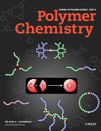Macroinitiator halide effects in galactoglucomannan-mediated single electron transfer-living radical polymerization
Abstract
Chloro (Cl)- and bromo (Br)-functionalized macroinitiators were successfully prepared from the softwood hemicellulose O-acetylated galactoglucomannan (AcGGM) and then explored and evaluated with respect to their ability and efficiency of initiating single electron transfer-living radical polymerization (SET-LRP). Both halogenated species effectively initiate SET-LRP of an acrylate and a methacrylate monomer, respectively, yielding brushlike AcGGM graft copolymers, where the molecular weights are accurately controlled via the monomer:macroinitiator ratio and polymerization time over a broad range: from oligomeric to ultrahigh. The nature of the halogen does not influence the kinetics of polymerization strongly, however, for acrylate graft polymerization, AcGGM-Cl gives a somewhat higher rate constant of propagation, while methacrylate grafting proceeds slightly faster when the initiating species is AcGGM-Br. For both monomers, the macroinitiator efficiency is superior in the case of AcGGM-Br. © 2011 Wiley Periodicals, Inc. J Polym Sci Part A: Polym Chem, 2011




